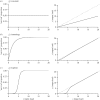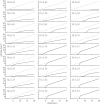Breaking beta: deconstructing the parasite transmission function
- PMID: 28289252
- PMCID: PMC5352811
- DOI: 10.1098/rstb.2016.0084
Breaking beta: deconstructing the parasite transmission function
Abstract
Transmission is a fundamental step in the life cycle of every parasite but it is also one of the most challenging processes to model and quantify. In most host-parasite models, the transmission process is encapsulated by a single parameter β Many different biological processes and interactions, acting on both hosts and infectious organisms, are subsumed in this single term. There are, however, at least two undesirable consequences of this high level of abstraction. First, nonlinearities and heterogeneities that can be critical to the dynamic behaviour of infections are poorly represented; second, estimating the transmission coefficient β from field data is often very difficult. In this paper, we present a conceptual model, which breaks the transmission process into its component parts. This deconstruction enables us to identify circumstances that generate nonlinearities in transmission, with potential implications for emergent transmission behaviour at individual and population scales. Such behaviour cannot be explained by the traditional linear transmission frameworks. The deconstruction also provides a clearer link to the empirical estimation of key components of transmission and enables the construction of flexible models that produce a unified understanding of the spread of both micro- and macro-parasite infectious disease agents.This article is part of the themed issue 'Opening the black box: re-examining the ecology and evolution of parasite transmission'.
Keywords: heterogeneity; infection; infectious disease; modelling; nonlinearities; transmission function.
© 2017 The Authors.
Figures



Similar articles
-
Global change, parasite transmission and disease control: lessons from ecology.Philos Trans R Soc Lond B Biol Sci. 2017 May 5;372(1719):20160088. doi: 10.1098/rstb.2016.0088. Philos Trans R Soc Lond B Biol Sci. 2017. PMID: 28289256 Free PMC article. Review.
-
Transmission dynamics: critical questions and challenges.Philos Trans R Soc Lond B Biol Sci. 2017 May 5;372(1719):20160087. doi: 10.1098/rstb.2016.0087. Philos Trans R Soc Lond B Biol Sci. 2017. PMID: 28289255 Free PMC article. Review.
-
The evolution of transmission mode.Philos Trans R Soc Lond B Biol Sci. 2017 May 5;372(1719):20160083. doi: 10.1098/rstb.2016.0083. Philos Trans R Soc Lond B Biol Sci. 2017. PMID: 28289251 Free PMC article. Review.
-
Who acquires infection from whom and how? Disentangling multi-host and multi-mode transmission dynamics in the 'elimination' era.Philos Trans R Soc Lond B Biol Sci. 2017 May 5;372(1719):20160091. doi: 10.1098/rstb.2016.0091. Philos Trans R Soc Lond B Biol Sci. 2017. PMID: 28289259 Free PMC article. Review.
-
Host heterogeneity affects both parasite transmission to and fitness on subsequent hosts.Philos Trans R Soc Lond B Biol Sci. 2017 May 5;372(1719):20160093. doi: 10.1098/rstb.2016.0093. Philos Trans R Soc Lond B Biol Sci. 2017. PMID: 28289260 Free PMC article.
Cited by
-
Virulence and transmission biology of the widespread, ecologically important pathogen of zooplankton, Spirobacillus cienkowskii.Appl Environ Microbiol. 2024 Oct 23;90(10):e0152923. doi: 10.1128/aem.01529-23. Epub 2024 Sep 12. Appl Environ Microbiol. 2024. PMID: 39264204
-
Centrifugation is an effective and inexpensive way to determine Batrachochytrium dendrobatidis quantity in water samples with low turbidity.Oecologia. 2024 Aug;205(3-4):437-443. doi: 10.1007/s00442-024-05604-0. Epub 2024 Aug 14. Oecologia. 2024. PMID: 39143251 Free PMC article.
-
Associating with kin selects for disease resistance and against tolerance.Proc Biol Sci. 2024 May;291(2023):20240356. doi: 10.1098/rspb.2024.0356. Epub 2024 May 22. Proc Biol Sci. 2024. PMID: 38772422 Free PMC article.
-
Quantifying the relationship between within-host dynamics and transmission for viral diseases of livestock.J R Soc Interface. 2024 Feb;21(211):20230445. doi: 10.1098/rsif.2023.0445. Epub 2024 Feb 14. J R Soc Interface. 2024. PMID: 38379412 Free PMC article.
-
Season of death, pathogen persistence and wildlife behaviour alter number of anthrax secondary infections from environmental reservoirs.Proc Biol Sci. 2024 Feb 14;291(2016):20232568. doi: 10.1098/rspb.2023.2568. Epub 2024 Feb 7. Proc Biol Sci. 2024. PMID: 38320613 Free PMC article.
References
-
- Barlow ND. 2000. Non-linear transmission and simple models for bovine tuberculosis. J. Anim. Ecol. 69, 703–713. (10.1046/j.1365-2656.2000.00428.x) - DOI
-
- Anderson RM, Nokes DJ. 1991. Mathematical models of transmission and control. In Oxford textbook of public health (eds Holland WW, Detels R, Knox G), pp. 225–252. Oxford, UK: Oxford University Press.
-
- Antolin MF. 2008. Unpacking beta: within-host dynamics and the evolutionary ecology of pathogen transmission. Annu. Rev. Ecol. Evol. Syst. 39, 415–437. (10.1146/annurev.ecolsys.37.091305.110119) - DOI
MeSH terms
Grants and funding
LinkOut - more resources
Full Text Sources
Other Literature Sources

